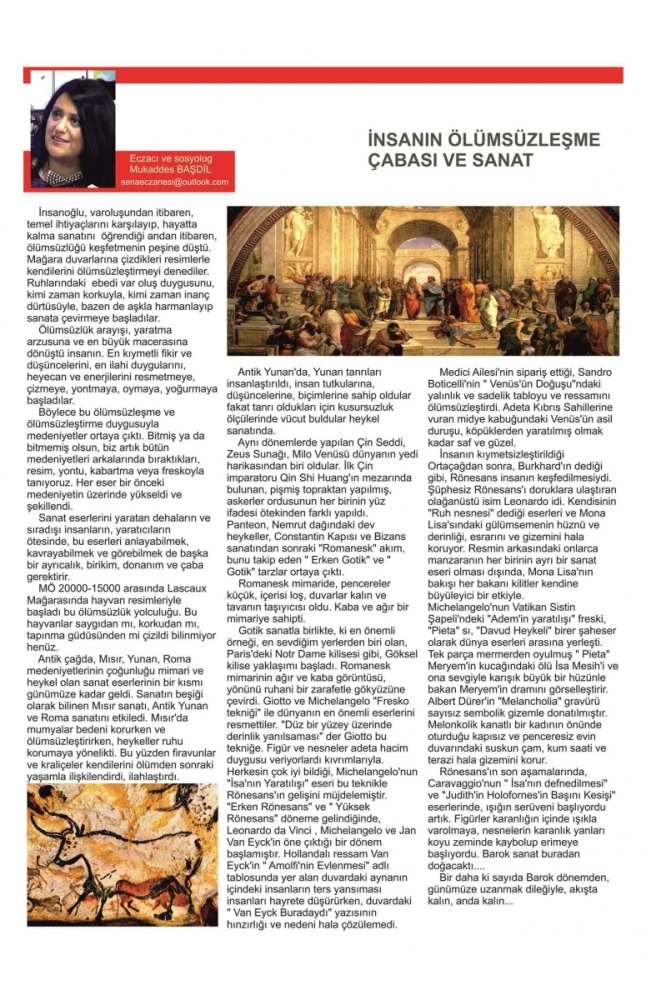No products

HUMAN STRIVING FOR IMMORTALIZATION AND ART
From the moment human beings met their basic needs and learned the art of survival, they sought to discover immortality. They tried to immortalize themselves by drawing pictures on cave walls. They began to blend the sense of eternal existence in their souls, sometimes with fear, sometimes with the urge to believe, sometimes with love, and turned it into art. The search for immortality turned into the desire to create and the greatest adventure of human beings. They began to paint, draw, sculpt, carve and knead their most precious ideas and thoughts, their most divine emotions, excitement and energy. Thus, civilizations emerged with this sense of immortalization and immortalization. Whether finished or unfinished, we now know all civilizations by the paintings, sculptures, reliefs or frescoes they left behind. Each work rose and took shape on the previous civilization. Beyond the geniuses, extraordinary people and creators who created these works of art, it requires another privilege, knowledge, equipment and effort to understand, comprehend and see these works. This journey to immortality began with animal paintings in the Lascaux Cave between 20000-15000 BC. It is not yet known whether these animals were drawn out of respect, fear or worship. In antiquity, some of the artworks of Egyptian, Greek and Roman civilizations, mostly architecture and sculpture, have survived to the present day. Egyptian art, known as the cradle of art, influenced ancient Greek and Roman art. In Egypt, mummies preserved and immortalized the body, while sculptures were intended to protect the soul. This is why pharaohs and queens associated themselves with the afterlife and deified themselves. And in Ancient Greece, the Greek gods were humanized, they had human passions, thoughts and forms, but because they were gods, they were embodied in perfection in the art of sculpture. The Great Wall of China, the Altar of Zeus and the Venus of Milo, built in the same period, became one of the seven wonders of the world. The facial expressions of the army of soldiers found in the tomb of the first Chinese emperor Qin Shi Huang, made of terracotta, were made different from each other. The Pantheon, the giant statues on Mount Nemrut, Constantine's Gate and the "Romanesque" movement after Byzantine art, followed by the "Early Gothic" and Gothic" styles emerged. After the Middle Ages, when man was devalued, the Renaissance was, as Burkhard says, the discovery of man. Undoubtedly, the extraordinary figure who brought the Renaissance to its climax was Leonardo. His works, which he himself called "objects of the soul", and the sadness and depth of the smile in his Mona Lisa, still preserve their mystery and mystery. Apart from the fact that each of the dozens of landscapes behind the painting is a separate work of art, Mona Lisa's gaze locks every beholder with a mesmerizing effect. Michelangelo's "The Creation of Adam" fresco, "Pieta" and "Statue of David" in the Sistine Chapel of the Vatican have become masterpieces of the world. Carved from a single piece of marble, "Pieta" visualizes the dead Jesus Christ in Mary's lap and the drama of Mary, who looks at him with great sadness mixed with love. Albert Dürer's engraving "Melancholia" is endowed with countless symbolic mysteries. The silent pine, the hourglass and the scales on the wall of the doorless and windowless house in front of which a melancholic winged woman sits still remain a mystery. With Gothic art, like the church of Notr Dame in Paris, the most important example of which is one of my favorite places, the Celestial church approach began. The heavy and rough look of Romanesque architecture was turned skyward with a spiritual grace. Giotto and Michelangelo painted the world's most important works with the "Fresco technique". Giotto called this technique "the illusion of depth on a flat surface". Figures and objects gave a sense of volume with their curves. Michelangelo's "The Creation of Christ", which everyone knows very well, heralded the arrival of the Renaissance with this technique. In the "Early Renaissance" and "High Renaissance" periods, in the last stages of the Renaissance, in Caravaggio's "The Burial of Christ" and "The Beheading of Holofornes by Judith", the adventure of light was beginning. Figures began to exist in the darkness with light, and a period in which Leonardo da Vinci, Michelangelo and Jan Van Eyck came to the fore. While the reverse reflection of the people in the mirror on the wall in Dutch painter Van Eyck's painting "The Marriage of Amolfi" amazed people, the mischief and the reason for the inscription "Van Eyck was here" on the wall are still unsolved. The simplicity and simplicity of Sandro Boticelli's "Birth of Venus", commissioned by the Medici Family, immortalized the painting and its painter. The noble stance of Venus in the mussel shell that washed up on the shores of Cyprus is as pure and beautiful as being created from foam. In Romanesque architecture, the windows were small, the interior was dim, the walls were thick and supported the ceiling. It was a rough and heavy architecture, disappearing and melting into the dark floor. Baroque art would be born here.... Hope to extend from the Baroque period to the present day in the next issue, stay in the flow, stay in the moment...

